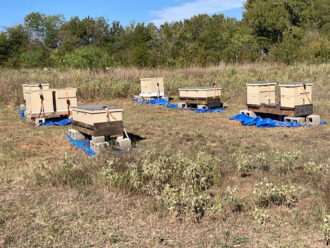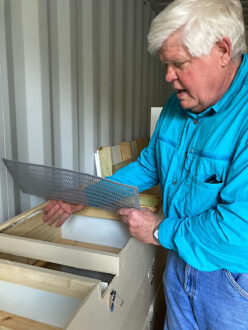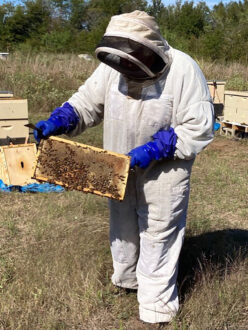MABANK, Texas – Texas beekeeper Daniel Brantner has a simple and economical solution for increasing honey production and improving the health of honey bees: redesigning the industry-standard bee hive boxes.
Brantner, owner of Texas Honey Company and a certified Texas master beekeeper, is using his skills as an architect to turn the typical standard 16”X22” beehive box into a two-queen horizontal beehive base.
“The standard boxes are stackable. Once the bees fill the frames of one box, you add a new box so that they move vertically in the space,” said Brantner. “My horizontal designs consist of two brood chambers and one honey chamber, sized to be compatible with industry standard boxes, separated by divider panels. The bees fill the space horizontally rather than vertically.”
Brantner said that the new designs allow for easier transport of colonies on pallets for pollination services and enable beekeepers to more easily collect honey and monitor the health of their hives without causing major disruptions to the bee colony. Most importantly, the horizontal boxes may dramatically increase honey production.

“The standard honey bee boxes have been around for over 170 years. It’s time they get an update,” said Brantner.
The beekeeper said he got his idea from a landmark study from the 1930s that correlated the size of the bee population to the amount of honey that was produced. The study found that honey production, as measured per thousand bees, in colonies with 30,000, 45,000 and 60,000 bees produced at a rate of 1.36, 1.47 and 1.54 times as much honey, respectively, compared to colonies with 15,000 bees.
“In theory,” said Brantner, “if you have two hives of 40,000 bees, the horizontal box designs allow for an 80,000 bee super colony, and honey production goes way up. It also allows for two queens to coexist in a single hive. Should one of the queens die, the hive will remain viable with the remaining queen until such time that the beekeeper can replace the dead queen.”
Brantner has received a Southern Sustainable Agriculture Research and Education (SSARE) Producer Grant to test his protoypes by measuring honey production and colony health compared to the industry standard bee boxes on 18 experimental hives. He manages his hives on his 20-acre property east of Dallas.

The general health of each colony will be monitored and recorded for pests, such as hive beetles, wax months and varroa mites on a bi-weekly basis throughout the year. Additionally, honey will be harvested and the total amount of honey produced over the two-year project period will be recorded.
Brantner said that the two-queen horizontal boxes are compatible with existing bee hive components, allowing a beekeeper to use industry standard components, as well as existing bee hive components to create a more productive, healthy colony.
“The goal is to keep the costs minimal for the average beekeeper,” said Brantner.
Brantner has filed for patents on his bee box designs and is hoping to replicate the study on a large scale.
The beekeeper has won several awards for his honey from the Texas Beekeepers Association and at the State Fair of Texas. Last year he harvested about 330 pounds of honey from his 12 traditional hives and sold out of his product in 15 minutes. His honey production this year was down by approximately 65 percent due to severe drought in Texas.
“People just really appreciate true, local honey,” he said.
